
List of National Historic Sites of Canada in Niagara Region
Encyclopedia
This is a list of National Historic Sites of Canada in Niagara Region, Ontario
. There are 26 National Historic Sites designated in Niagara, of which seven are administered by Parks Canada
.
National Historic Sites located elsewhere in Ontario are listed at List of National Historic Sites of Canada in Ontario.
This list uses the designation names as recognized by the Historic Sites and Monuments Board of Canada, not necessarily the official or colloquial names of the sites.
Ontario
Ontario is a province of Canada, located in east-central Canada. It is Canada's most populous province and second largest in total area. It is home to the nation's most populous city, Toronto, and the nation's capital, Ottawa....
. There are 26 National Historic Sites designated in Niagara, of which seven are administered by Parks Canada
Parks Canada
Parks Canada , also known as the Parks Canada Agency , is an agency of the Government of Canada mandated to protect and present nationally significant natural and cultural heritage, and foster public understanding, appreciation, and enjoyment in ways that ensure their ecological and commemorative...
.
National Historic Sites located elsewhere in Ontario are listed at List of National Historic Sites of Canada in Ontario.
This list uses the designation names as recognized by the Historic Sites and Monuments Board of Canada, not necessarily the official or colloquial names of the sites.
National Historic Sites
| Site | Date(s) | Designated | Location | Description | Image |
|---|---|---|---|---|---|
| Battle of Beaver Dams Battle of Beaver Dams The Battle of Beaver Dams took place on 24 June 1813, during the War of 1812. An American column marched from Fort George and attempted to surprise a British outpost at Beaver Dams, billeting themselves overnight in the village of Queenston, Ontario... |
1813 (battle) | 1921 | Thorold Thorold, Ontario Thorold is a city in Ontario, Canada, located on the Niagara Escarpment. It is also the seat of the Regional Municipality of Niagara.... 43.117776°N 79.185419°W |
The site of a decisive British victory during the War of 1812 War of 1812 The War of 1812 was a military conflict fought between the forces of the United States of America and those of the British Empire. The Americans declared war in 1812 for several reasons, including trade restrictions because of Britain's ongoing war with France, impressment of American merchant... , after heroine Laura Secord Laura Secord Laura Ingersoll Secord was a Canadian heroine of the War of 1812. She is known for warning British forces of an impending American attack that led to the British victory at the Battle of Beaver Dams.-Early life:... had earlier struck out on a long and difficult trek to warn the British of an impending American attack |
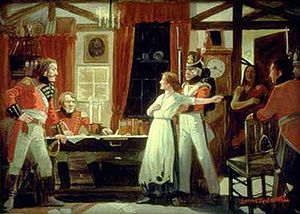 |
| Battle of Chippawa Battle of Chippawa The Battle of Chippawa was a victory for the United States Army in the War of 1812, during an invasion of Upper Canada along the Niagara River on July 5, 1814.-Background:... |
1814 (battle) | 1921 | Chippawa Chippawa, Ontario Chippawa is a community located within the city of Niagara Falls, Ontario.The village was founded in 1850, and became part of the City of Niagara Falls, Ontario by amalgamation in 1970. It is located on the Canadian shore of the Niagara River about 2 km upstream from Niagara Falls. It is... 43.052127°N 79.024720°W |
The site of a battle that took place during the War of 1812 War of 1812 The War of 1812 was a military conflict fought between the forces of the United States of America and those of the British Empire. The Americans declared war in 1812 for several reasons, including trade restrictions because of Britain's ongoing war with France, impressment of American merchant... as a result of the last major American invasion of Canada |
 |
| Battle of Cook's Mills Battle of Cook's Mills The Battle of Cook's Mills was the last engagement between U.S. and British armies in the Niagara, and the penultimate engagement on Canadian soil during the War of 1812.-Background:... |
1814 (battle) | 1921 | Cooks Mills 42.997895°N 79.174913°W |
The site of the last engagement between U.S. and British/Canadian armies fought in Niagara Niagara Peninsula The Niagara Peninsula is the portion of Southern Ontario, Canada lying between the south shore of Lake Ontario and the north shore of Lake Erie. It stretches from the Niagara River in the east to Hamilton, Ontario in the west. The population of the peninsula is roughly 1,000,000 people... , and second-last on Canadian soil during the War of 1812 War of 1812 The War of 1812 was a military conflict fought between the forces of the United States of America and those of the British Empire. The Americans declared war in 1812 for several reasons, including trade restrictions because of Britain's ongoing war with France, impressment of American merchant... |
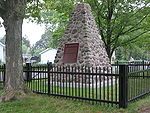 |
| Battle of Lundy's Lane Battle of Lundy's Lane The Battle of Lundy's Lane was a battle of the Anglo-American War of 1812, which took place on 25 July 1814, in present-day Niagara Falls, Ontario... |
1814 (battle) | 1937 | Niagara Falls Niagara Falls, Ontario Niagara Falls is a Canadian city on the Niagara River in the Golden Horseshoe region of Southern Ontario. The municipality was incorporated on June 12, 1903... 43.089152°N 79.095456°W |
The site of a spontaneous confrontation between the British and American forces in which the British attacked American forces returning from the Battle of Chippawa Battle of Chippawa The Battle of Chippawa was a victory for the United States Army in the War of 1812, during an invasion of Upper Canada along the Niagara River on July 5, 1814.-Background:... ; the six-hour long battle was one of the bloodiest battles of the War of 1812 War of 1812 The War of 1812 was a military conflict fought between the forces of the United States of America and those of the British Empire. The Americans declared war in 1812 for several reasons, including trade restrictions because of Britain's ongoing war with France, impressment of American merchant... and marked the end of American offensive in Upper Canada Upper Canada The Province of Upper Canada was a political division in British Canada established in 1791 by the British Empire to govern the central third of the lands in British North America and to accommodate Loyalist refugees from the United States of America after the American Revolution... |
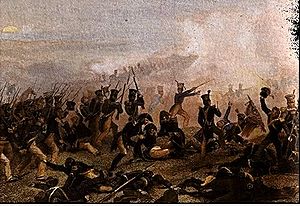 |
| Battlefield of Fort George Battle of Fort George The Battle of Fort George was a battle fought during the War of 1812, in which the Americans defeated a British force and captured the Fort George in Upper Canada... |
1813 (battle) | 1921 | Niagara-on-the-Lake Niagara-on-the-Lake Niagara-on-the-Lake is a Canadian town located in Southern Ontario where the Niagara River meets Lake Ontario in the Niagara Region of the southern part of the province of Ontario. It is located across the Niagara river from Youngstown, New York, USA... 43°15.722′N 79°05.071′W |
The site of one of the fiercest battles of the War of 1812 War of 1812 The War of 1812 was a military conflict fought between the forces of the United States of America and those of the British Empire. The Americans declared war in 1812 for several reasons, including trade restrictions because of Britain's ongoing war with France, impressment of American merchant... , in which the U.S. managed to gain a toehold on the Niagara Peninsula; distinct from nearby Fort George Fort George, Ontario Fort George National Historic Site is a historic military structure at Niagara-on-the-Lake, Ontario, that was the scene of several battles during the War of 1812... National Historic Site |
|
| Butler's Barracks Butler's Barracks Butler's Barracks was the home of Loyalist military officer John Butler , in what was then Newark, Upper Canada; present day Niagara-on-the-Lake, Ontario... |
1814–54 (completed) | 1963 | Niagara-on-the-Lake Niagara-on-the-Lake Niagara-on-the-Lake is a Canadian town located in Southern Ontario where the Niagara River meets Lake Ontario in the Niagara Region of the southern part of the province of Ontario. It is located across the Niagara river from Youngstown, New York, USA... 43.248370°N 79.074044°W |
A complex of five wooden buildings, built by the British after the War of 1812 War of 1812 The War of 1812 was a military conflict fought between the forces of the United States of America and those of the British Empire. The Americans declared war in 1812 for several reasons, including trade restrictions because of Britain's ongoing war with France, impressment of American merchant... and occupied as a military camp until the 1960s, representing 150 years of military history |
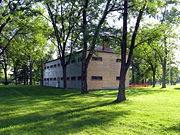 |
| Former L.J. Shickluna Service Station | 1924 (c.) (completed) | 1995 | Port Colborne Port Colborne, Ontario Port Colborne is a city on Lake Erie, at the southern end of the Welland Canal, in the Niagara Region of southern Ontario, Canada... 42.887941°N 79.251214°W |
Early service station Filling station A filling station, also known as a fueling station, garage, gasbar , gas station , petrol bunk , petrol pump , petrol garage, petrol kiosk , petrol station "'servo"' in Australia or service station, is a facility which sells fuel and lubricants... |
|
| Fort Drummond Fort Drummond Fort Drummond was the site of a redoubt and battery from the War of 1812 and located within Queenston Heights.The U-shaped structure was an earthworks rather than a wood, brick or rock construction.... |
1814 (completed) | 1928 | Niagara-on-the-Lake Niagara-on-the-Lake Niagara-on-the-Lake is a Canadian town located in Southern Ontario where the Niagara River meets Lake Ontario in the Niagara Region of the southern part of the province of Ontario. It is located across the Niagara river from Youngstown, New York, USA... 43.160147°N 79.052234°W |
A redoubt Redoubt A redoubt is a fort or fort system usually consisting of an enclosed defensive emplacement outside a larger fort, usually relying on earthworks, though others are constructed of stone or brick. It is meant to protect soldiers outside the main defensive line and can be a permanent structure or a... and battery Artillery battery In military organizations, an artillery battery is a unit of guns, mortars, rockets or missiles so grouped in order to facilitate better battlefield communication and command and control, as well as to provide dispersion for its constituent gunnery crews and their systems... constructed during the War of 1812 War of 1812 The War of 1812 was a military conflict fought between the forces of the United States of America and those of the British Empire. The Americans declared war in 1812 for several reasons, including trade restrictions because of Britain's ongoing war with France, impressment of American merchant... to protect the main portage road from Chippawa Chippawa, Ontario Chippawa is a community located within the city of Niagara Falls, Ontario.The village was founded in 1850, and became part of the City of Niagara Falls, Ontario by amalgamation in 1970. It is located on the Canadian shore of the Niagara River about 2 km upstream from Niagara Falls. It is... to Queenston Queenston, Ontario Queenston is located 5 km north of Niagara Falls, Ontario in the Town of Niagara-on-the-Lake. The community is bordered by Highway 405 and the Niagara River; its location on the Niagara Escarpment led to the establishment of the now-defunct Queenston Quarry in the area... , named after Sir Gordon Drummond; some walls of the redoubt are still extant |
|
| Fort Erie Fort Erie Fort Erie was the first British fort to be constructed as part of a network developed after the Seven Years' War was concluded by the Treaty of Paris at which time all of New France had been ceded to Great Britain... |
1808 (completion of third Fort Erie) | 1933 | Fort Erie (town) Fort Erie, Ontario Fort Erie is a town on the Niagara River in the Niagara Region, Ontario, Canada. It is located directly across the river from Buffalo, New York.... 42°53′35.70"N 78°55′25.74"W |
The first British fort Fortification Fortifications are military constructions and buildings designed for defence in warfare and military bases. Humans have constructed defensive works for many thousands of years, in a variety of increasingly complex designs... to be constructed as part of a network developed after the Seven Years' War Seven Years' War The Seven Years' War was a global military war between 1756 and 1763, involving most of the great powers of the time and affecting Europe, North America, Central America, the West African coast, India, and the Philippines... in the western portion of the Province of Quebec (later Upper Canada Upper Canada The Province of Upper Canada was a political division in British Canada established in 1791 by the British Empire to govern the central third of the lands in British North America and to accommodate Loyalist refugees from the United States of America after the American Revolution... ); captured and destroyed in 1814 by invading American forces during the War of 1812 War of 1812 The War of 1812 was a military conflict fought between the forces of the United States of America and those of the British Empire. The Americans declared war in 1812 for several reasons, including trade restrictions because of Britain's ongoing war with France, impressment of American merchant... , the remains of the fort were rebuilt by the Niagara Parks Commission Niagara Parks Commission The Niagara Parks Commission, or Niagara Parks for short, is an agency of government of Ontario which maintains the Ontario shoreline of the Niagara River.- History :... in 1937–39 |
 |
| Fort George Fort George, Ontario Fort George National Historic Site is a historic military structure at Niagara-on-the-Lake, Ontario, that was the scene of several battles during the War of 1812... |
1799 (completed), 1940 (reconstruction completed) | 1921 | Niagara-on-the-Lake Niagara-on-the-Lake Niagara-on-the-Lake is a Canadian town located in Southern Ontario where the Niagara River meets Lake Ontario in the Niagara Region of the southern part of the province of Ontario. It is located across the Niagara river from Youngstown, New York, USA... 43°15′03"N 79°03′40"W |
Reconstructed British fort that served as the principal fortification on the Niagara Peninsula Niagara Peninsula The Niagara Peninsula is the portion of Southern Ontario, Canada lying between the south shore of Lake Ontario and the north shore of Lake Erie. It stretches from the Niagara River in the east to Hamilton, Ontario in the west. The population of the peninsula is roughly 1,000,000 people... during the War of 1812 War of 1812 The War of 1812 was a military conflict fought between the forces of the United States of America and those of the British Empire. The Americans declared war in 1812 for several reasons, including trade restrictions because of Britain's ongoing war with France, impressment of American merchant... ; distinct from the nearby Battlefield of Fort George Battle of Fort George The Battle of Fort George was a battle fought during the War of 1812, in which the Americans defeated a British force and captured the Fort George in Upper Canada... National Historic Site |
|
| Fort Mississauga Fort Mississauga Fort Mississauga National Historic Site is a fort along the shore of Lake Ontario, not far from the Niagara River in Niagara-on-the-Lake, Ontario. The fort today consists of a box–shaped brick tower and historic star–shaped earthworks—the only one in the country... |
1814 (completed) | 1960 | Niagara-on-the-Lake Niagara-on-the-Lake Niagara-on-the-Lake is a Canadian town located in Southern Ontario where the Niagara River meets Lake Ontario in the Niagara Region of the southern part of the province of Ontario. It is located across the Niagara river from Youngstown, New York, USA... 43°15′42"N 79°04′36"W |
Located in a strategic position at the mouth of the Niagara River Niagara River The Niagara River flows north from Lake Erie to Lake Ontario. It forms part of the border between the Province of Ontario in Canada and New York State in the United States. There are differing theories as to the origin of the name of the river... to protect the Canadian frontier and to counter Fort Niagara Fort Niagara Fort Niagara is a fortification originally built to protect the interests of New France in North America. It is located near Youngstown, New York, on the eastern bank of the Niagara River at its mouth, on Lake Ontario.-Origin:... on the U.S. side, it is the only remaining fortification of its type (a square tower within a star-shaped earthwork) in Canada |
|
| Frenchman's Creek Battle of Frenchman's Creek The Battle of Frenchman’s Creek took place during the War of 1812 between Great Britain and the United States in the early hours of November 28, 1812, in the Crown Colony of Upper Canada, near the Niagara River. The operation was conceived as a raid to prepare the ground for a larger American... |
1812 (battle) | 1921 | Fort Erie Fort Erie, Ontario Fort Erie is a town on the Niagara River in the Niagara Region, Ontario, Canada. It is located directly across the river from Buffalo, New York.... 42.94227°N 78.92645°W |
The battle of Frenchman’s Creek was a minor skirmish in the War of 1812 War of 1812 The War of 1812 was a military conflict fought between the forces of the United States of America and those of the British Empire. The Americans declared war in 1812 for several reasons, including trade restrictions because of Britain's ongoing war with France, impressment of American merchant... , where British forces pushed an American advance parties back across the Niagara River Niagara River The Niagara River flows north from Lake Erie to Lake Ontario. It forms part of the border between the Province of Ontario in Canada and New York State in the United States. There are differing theories as to the origin of the name of the river... ; the failure of American troops contributed, in part, to the cancellation of the larger invasion planned for the Niagara peninsula at the end of 1812 |
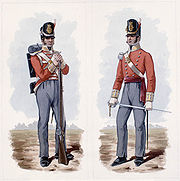 |
| Mississauga Point Lighthouse | 1804 (completed), 1814 (demolished) | 1937 | Niagara-on-the-Lake Niagara-on-the-Lake Niagara-on-the-Lake is a Canadian town located in Southern Ontario where the Niagara River meets Lake Ontario in the Niagara Region of the southern part of the province of Ontario. It is located across the Niagara river from Youngstown, New York, USA... 43°15′41.92"N 79°4′35.86"W |
The first lighthouse Lighthouse A lighthouse is a tower, building, or other type of structure designed to emit light from a system of lamps and lenses or, in older times, from a fire, and used as an aid to navigation for maritime pilots at sea or on inland waterways.... on the Great Lakes Great Lakes The Great Lakes are a collection of freshwater lakes located in northeastern North America, on the Canada – United States border. Consisting of Lakes Superior, Michigan, Huron, Erie, and Ontario, they form the largest group of freshwater lakes on Earth by total surface, coming in second by volume... , constructed in 1804 by the military masons of the 49th Regiment of Foot 49th (Princess Charlotte of Wales's) (Hertfordshire) Regiment of Foot The 49th Regiment of Foot was a British Army line infantry regiment. During the Childers Reforms it was united with the 66th Regiment of Foot to form Princess Charlotte of Wales's Berkshire Regiment.-Service history:The 49th Regiment was formed in 1744, during the War of the Austrian Succession... , it was damaged in the Battle of Fort George Battle of Fort George The Battle of Fort George was a battle fought during the War of 1812, in which the Americans defeated a British force and captured the Fort George in Upper Canada... in 1813, and demolished in 1814 when the British built Fort Mississauga Fort Mississauga Fort Mississauga National Historic Site is a fort along the shore of Lake Ontario, not far from the Niagara River in Niagara-on-the-Lake, Ontario. The fort today consists of a box–shaped brick tower and historic star–shaped earthworks—the only one in the country... on the site |
|
| Navy Island Navy Island Navy Island is a small island in the Niagara River in the province of Ontario, managed by Parks Canada as a National Historic Site of Canada. It is located about upstream from Horseshoe Falls, and has an area of roughly... |
1804 (completed), 1814 (demolished) | 1921 | Niagara Falls Niagara Falls, Ontario Niagara Falls is a Canadian city on the Niagara River in the Golden Horseshoe region of Southern Ontario. The municipality was incorporated on June 12, 1903... 43°3′23.07"N 79°0′38.1"W |
Archaeological remains Archaeological site An archaeological site is a place in which evidence of past activity is preserved , and which has been, or may be, investigated using the discipline of archaeology and represents a part of the archaeological record.Beyond this, the definition and geographical extent of a 'site' can vary widely,... on an uninhabited island on the Ontario side of the Niagara River Niagara River The Niagara River flows north from Lake Erie to Lake Ontario. It forms part of the border between the Province of Ontario in Canada and New York State in the United States. There are differing theories as to the origin of the name of the river... ; during the 1760s, the island was home to the first British shipyard Shipyard Shipyards and dockyards are places which repair and build ships. These can be yachts, military vessels, cruise liners or other cargo or passenger ships. Dockyards are sometimes more associated with maintenance and basing activities than shipyards, which are sometimes associated more with initial... to serve the Upper Great Lakes Great Lakes The Great Lakes are a collection of freshwater lakes located in northeastern North America, on the Canada – United States border. Consisting of Lakes Superior, Michigan, Huron, Erie, and Ontario, they form the largest group of freshwater lakes on Earth by total surface, coming in second by volume... and, during the Upper Canada Rebellion Upper Canada Rebellion The Upper Canada Rebellion was, along with the Lower Canada Rebellion in Lower Canada, a rebellion against the British colonial government in 1837 and 1838. Collectively they are also known as the Rebellions of 1837.-Issues:... , the seat of William Lyon Mackenzie William Lyon Mackenzie William Lyon Mackenzie was a Scottish born American and Canadian journalist, politician, and rebellion leader. He served as the first mayor of Toronto, Upper Canada and was an important leader during the 1837 Upper Canada Rebellion.-Background and early years in Scotland, 1795–1820:Mackenzie was... ’s exiled government, the Republic of Canada Republic of Canada The Republic of Canada was a declared government proclaimed by William Lyon Mackenzie on December 13, 1837. The self proclaimed government was established on Navy Island in the Niagara River in the latter days of the Upper Canada Rebellion after Mackenzie and 200 of his followers retreated from... |
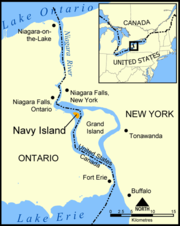 |
| Niagara Apothecary | 1820 (completed) | 1968 | Niagara-on-the-Lake Niagara-on-the-Lake Niagara-on-the-Lake is a Canadian town located in Southern Ontario where the Niagara River meets Lake Ontario in the Niagara Region of the southern part of the province of Ontario. It is located across the Niagara river from Youngstown, New York, USA... 43°15′18.25"N 79°4′15.3"W |
A white, single-storey clapboard Clapboard (architecture) Clapboard, also known as bevel siding or lap siding or weather-board , is a board used typically for exterior horizontal siding that has one edge thicker than the other and where the board above laps over the one below... Georgian Georgian architecture Georgian architecture is the name given in most English-speaking countries to the set of architectural styles current between 1720 and 1840. It is eponymous for the first four British monarchs of the House of Hanover—George I of Great Britain, George II of Great Britain, George III of the United... building on Niagara-on-the-Lake’s main commercial street, it served as an apothecary Apothecary Apothecary is a historical name for a medical professional who formulates and dispenses materia medica to physicians, surgeons and patients — a role now served by a pharmacist and some caregivers.... /pharmacy from approximately 1866 to 1964 and it is one of the very few remaining examples of an old apothecary shop |
|
| Niagara District Court House | 1847 (completed) | 1980 | Niagara-on-the-Lake Niagara-on-the-Lake Niagara-on-the-Lake is a Canadian town located in Southern Ontario where the Niagara River meets Lake Ontario in the Niagara Region of the southern part of the province of Ontario. It is located across the Niagara river from Youngstown, New York, USA... 43°15′18.25"N 79°4′15.3"W |
Designed by William Thomas William Thomas (architect) William Thomas was an Anglo-Canadian architect.Thomas was apprenticed under Charles Barry and A.W. Pugin as a carpenter-joiner. His younger brother was the sculptor John Thomas .Thomas began his own practice at Leamington Spa in 1831 but in 1837 went bankrupt... in the Neoclassical style Neoclassical architecture Neoclassical architecture was an architectural style produced by the neoclassical movement that began in the mid-18th century, manifested both in its details as a reaction against the Rococo style of naturalistic ornament, and in its architectural formulas as an outgrowth of some classicizing... , it is an excellent example of a mid-19th-century multipurpose civic structure, originally containing the local court house, jail, market and town hall |
|
| Niagara-on-the-Lake Niagara-on-the-Lake Niagara-on-the-Lake is a Canadian town located in Southern Ontario where the Niagara River meets Lake Ontario in the Niagara Region of the southern part of the province of Ontario. It is located across the Niagara river from Youngstown, New York, USA... |
1815–59 (completed) | 2003 | Niagara-on-the-Lake Niagara-on-the-Lake Niagara-on-the-Lake is a Canadian town located in Southern Ontario where the Niagara River meets Lake Ontario in the Niagara Region of the southern part of the province of Ontario. It is located across the Niagara river from Youngstown, New York, USA... 43°15′18.02"N 79°4′18.6"W |
An early-19th-century Loyalist town located on the southern shore of Lake Ontario Lake Ontario Lake Ontario is one of the five Great Lakes of North America. It is bounded on the north and southwest by the Canadian province of Ontario, and on the south by the American state of New York. Ontario, Canada's most populous province, was named for the lake. In the Wyandot language, ontarío means... ; the historic district covers 25 city block City block A city block, urban block or simply block is a central element of urban planning and urban design. A city block is the smallest area that is surrounded by streets. City blocks are the space for buildings within the street pattern of a city, they form the basic unit of a city's urban fabric... s and contains the best collection of buildings in Canada from the period following the War of 1812 War of 1812 The War of 1812 was a military conflict fought between the forces of the United States of America and those of the British Empire. The Americans declared war in 1812 for several reasons, including trade restrictions because of Britain's ongoing war with France, impressment of American merchant... |
 |
| Point Abino Light Tower | 1918 (completed) | 1998 | Crystal Beach Crystal Beach, Ontario Crystal Beach is a community within Fort Erie, Ontario with a population of 3,800. It was named for the "crystal-clear" water conditions present when it was founded on the northeast shore of Lake Erie, across from Buffalo.... 42°50′7.85"N 79°5′42.64"W |
A lighthouse Lighthouse A lighthouse is a tower, building, or other type of structure designed to emit light from a system of lamps and lenses or, in older times, from a fire, and used as an aid to navigation for maritime pilots at sea or on inland waterways.... situated at the eastern end of Lake Erie Lake Erie Lake Erie is the fourth largest lake of the five Great Lakes in North America, and the tenth largest globally. It is the southernmost, shallowest, and smallest by volume of the Great Lakes and therefore also has the shortest average water residence time. It is bounded on the north by the... ; intended to complement the summer homes nearby, it was more elaborately designed than most Canadian lighthouses, with a high level of its features still intact |
|
| Queenston Heights Queenston Heights thumb|Brock's Monument|250px|Brock's Monument at Queenston HeightsThe Queenston Heights is a geographical feature of the Niagara Escarpment immediately above the village of Queenston, Ontario, Canada. Its geography is a promontory formed where the escarpment is divided by the Niagara River... |
1812 (battle) | 1968 | Niagara-on-the-Lake Niagara-on-the-Lake Niagara-on-the-Lake is a Canadian town located in Southern Ontario where the Niagara River meets Lake Ontario in the Niagara Region of the southern part of the province of Ontario. It is located across the Niagara river from Youngstown, New York, USA... 43.160147°N 79.052234°W |
A treed promontory Promontory Promontory may refer to:*Promontory, a prominent mass of land which overlooks lower lying land or a body of water*Promontory, Utah, the location where the United States first Transcontinental Railroad was completed... on the Niagara Escarpment Niagara Escarpment The Niagara Escarpment is a long escarpment, or cuesta, in the United States and Canada that runs westward from New York State, through Ontario, Michigan, Wisconsin and Illinois... , where the British repulsed an American invasion in the Battle of Queenston Heights Battle of Queenston Heights The Battle of Queenston Heights was the first major battle in the War of 1812 and resulted in a British victory. It took place on 13 October 1812, near Queenston, in the present-day province of Ontario... in the War of 1812 War of 1812 The War of 1812 was a military conflict fought between the forces of the United States of America and those of the British Empire. The Americans declared war in 1812 for several reasons, including trade restrictions because of Britain's ongoing war with France, impressment of American merchant... ; site of Brock's Monument Brock's Monument Brock's Monument is a 56-metre column atop Queenston Heights, in Queenston, Ontario, Canada, dedicated to Major General Sir Isaac Brock, one of Canada's heroes of the War of 1812... and a monument to Laura Secord Laura Secord Laura Ingersoll Secord was a Canadian heroine of the War of 1812. She is known for warning British forces of an impending American attack that led to the British victory at the Battle of Beaver Dams.-Early life:... |
|
| Queenston-Chippawa Hydro-electric Plant | 1925 (completed) | 1990 | Niagara-on-the-Lake Niagara-on-the-Lake Niagara-on-the-Lake is a Canadian town located in Southern Ontario where the Niagara River meets Lake Ontario in the Niagara Region of the southern part of the province of Ontario. It is located across the Niagara river from Youngstown, New York, USA... 43°8′45.47"N 79°2′43.55"W |
At the time of its completion, it was the first large-scale hydroelectric generation project in the world | |
| R. Nathaniel Dett British Methodist Episcopal Church | 1836 (completed) | 1999 | Niagara Falls Niagara Falls, Ontario Niagara Falls is a Canadian city on the Niagara River in the Golden Horseshoe region of Southern Ontario. The municipality was incorporated on June 12, 1903... 43°5′16.1"N 79°5′14.95"W |
A British Methodist Episcopal Church British Methodist Episcopal Church The British Methodist Episcopal Church is a Protestant church in Canada that has its roots in the African Methodist Episcopal Church of the United States.... chapel named after and associated with the formative years of composer Robert Nathaniel Dett Robert Nathaniel Dett Robert Nathaniel Dett , often known as R. Nathaniel Dett, was a composer in the United States and Canada... ; representative of early black African American African Americans are citizens or residents of the United States who have at least partial ancestry from any of the native populations of Sub-Saharan Africa and are the direct descendants of enslaved Africans within the boundaries of the present United States... settlement in the Niagara area and the church's role in assisting Underground Railroad Underground Railroad The Underground Railroad was an informal network of secret routes and safe houses used by 19th-century black slaves in the United States to escape to free states and Canada with the aid of abolitionists and allies who were sympathetic to their cause. The term is also applied to the abolitionists,... refugees |
|
| Ridgeway Battlefield Battle of Ridgeway The Battle of Ridgeway was fought in the vicinity of the town of Fort Erie across the Niagara River from Buffalo, NY near the village of Ridgeway, Canada West, currently Ontario, Canada on June 2, 1866, between Canadian troops and an irregular army of Irish-American invaders, the Fenians... |
1866 (battle) | 1921 | Fort Erie Fort Erie, Ontario Fort Erie is a town on the Niagara River in the Niagara Region, Ontario, Canada. It is located directly across the river from Buffalo, New York.... 42.904349°N 79.041642°W |
The site of the battlefield where the Queen’s Own Rifles The Queen's Own Rifles of Canada The Queen's Own Rifles of Canada is a militia regiment within the Canadian Forces, based in Toronto, Ontario. The regiment is part of Land Force Central Area's 32 Canadian Brigade Group. It is the only Primary Reserve regiment in Canada to have a parachute role. The regiment consists of the reserve... , 13th Hamilton Battalion The Royal Hamilton Light Infantry (Wentworth Regiment) The Royal Hamilton Light Infantry is a Primary Reserve unit of the Canadian Forces based at John W. Foote VC Armouries in Hamilton, Ontario.... , and Caledonia and York Rifle Companies of Haldimand defended Canada against Fenian raiders Fenian raids Between 1866 and 1871, the Fenian raids of the Fenian Brotherhood who were based in the United States; on British army forts, customs posts and other targets in Canada, were fought to bring pressure on Britain to withdraw from Ireland. They divided many Catholic Irish-Canadians, many of whom were... from the United States |
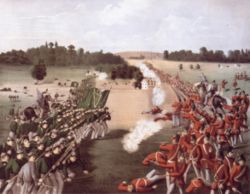 |
| Salem Chapel, British Methodist Episcopal Church | 1855 (completed) | 1999 | St. Catharines St. Catharines, Ontario St. Catharines is the largest city in Canada's Niagara Region and the sixth largest urban area in Ontario, Canada, with 97.11 square kilometres of land... 43°9′54.71"N 79°14′24.16"W |
A gable Gable A gable is the generally triangular portion of a wall between the edges of a sloping roof. The shape of the gable and how it is detailed depends on the structural system being used and aesthetic concerns. Thus the type of roof enclosing the volume dictates the shape of the gable... -fronted church representative of the auditory-hall design of Underground Railroad Underground Railroad The Underground Railroad was an informal network of secret routes and safe houses used by 19th-century black slaves in the United States to escape to free states and Canada with the aid of abolitionists and allies who were sympathetic to their cause. The term is also applied to the abolitionists,... -related churches; an important centre of 19th-century abolitionist Abolitionism Abolitionism is a movement to end slavery.In western Europe and the Americas abolitionism was a movement to end the slave trade and set slaves free. At the behest of Dominican priest Bartolomé de las Casas who was shocked at the treatment of natives in the New World, Spain enacted the first... activity in Canada, associated with Harriet Tubman Harriet Tubman Harriet Tubman Harriet Tubman Harriet Tubman (born Araminta Harriet Ross; (1820 – 1913) was an African-American abolitionist, humanitarian, and Union spy during the American Civil War. After escaping from slavery, into which she was born, she made thirteen missions to rescue more than 70 slaves... |
|
| Toronto Power Generating Station Toronto Power Generating Station The Toronto Power Generating Station is a former generating station located along the Niagara River in Niagara Falls, Ontario, Canada, slightly upstream from the newer Rankine power station. Completed in 1906 in the Beaux-Arts-style, the station was designed by architect E. J. Lennox and was built... |
1913 (completed) | 1983 | Niagara Falls Niagara Falls, Ontario Niagara Falls is a Canadian city on the Niagara River in the Golden Horseshoe region of Southern Ontario. The municipality was incorporated on June 12, 1903... 43°4′19.45"N 79°4′25.74"W |
A generating station Power station A power station is an industrial facility for the generation of electric energy.... to supply hydro-electric Hydroelectricity Hydroelectricity is the term referring to electricity generated by hydropower; the production of electrical power through the use of the gravitational force of falling or flowing water. It is the most widely used form of renewable energy... power to Toronto, it was the first wholly Canadian-owned hydro-electric facility at Niagara Falls Niagara Falls The Niagara Falls, located on the Niagara River draining Lake Erie into Lake Ontario, is the collective name for the Horseshoe Falls and the adjacent American Falls along with the comparatively small Bridal Veil Falls, which combined form the highest flow rate of any waterfalls in the world and has... ; an elegant and unusual application of Beaux-Arts design to an industrial site in Canada |
|
| Willowbank | 1836 (completed) | 2003 | Niagara-on-the-Lake Niagara-on-the-Lake Niagara-on-the-Lake is a Canadian town located in Southern Ontario where the Niagara River meets Lake Ontario in the Niagara Region of the southern part of the province of Ontario. It is located across the Niagara river from Youngstown, New York, USA... 43.16773°N 79.05796°W |
A 5 hectares (12.4 acre) estate with a large three-and-a-half storey temple-fronted mansion Mansion A mansion is a very large dwelling house. U.S. real estate brokers define a mansion as a dwelling of over . A traditional European mansion was defined as a house which contained a ballroom and tens of bedrooms... ; the landscaping and largely unchanged exterior architecture are symbolic of the fusion of Neoclassical architecture Neoclassical architecture Neoclassical architecture was an architectural style produced by the neoclassical movement that began in the mid-18th century, manifested both in its details as a reaction against the Rococo style of naturalistic ornament, and in its architectural formulas as an outgrowth of some classicizing... and the Picturesque Picturesque Picturesque is an aesthetic ideal introduced into English cultural debate in 1782 by William Gilpin in Observations on the River Wye, and Several Parts of South Wales, etc. Relative Chiefly to Picturesque Beauty; made in the Summer of the Year 1770, a practical book which instructed England's... ideal that characterized large country estates of Upper Canada Upper Canada The Province of Upper Canada was a political division in British Canada established in 1791 by the British Empire to govern the central third of the lands in British North America and to accommodate Loyalist refugees from the United States of America after the American Revolution... in the early 19th century |
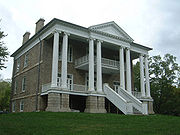 |
| Vrooman's Battery | 1812 (battle) | 1921 | Niagara-on-the-Lake Niagara-on-the-Lake Niagara-on-the-Lake is a Canadian town located in Southern Ontario where the Niagara River meets Lake Ontario in the Niagara Region of the southern part of the province of Ontario. It is located across the Niagara river from Youngstown, New York, USA... 43°10′41.76"N 79°3′30.05"W |
An artillery battery Artillery battery In military organizations, an artillery battery is a unit of guns, mortars, rockets or missiles so grouped in order to facilitate better battlefield communication and command and control, as well as to provide dispersion for its constituent gunnery crews and their systems... that maintained a harassing fire on the American forces crossing the Niagara River Niagara River The Niagara River flows north from Lake Erie to Lake Ontario. It forms part of the border between the Province of Ontario in Canada and New York State in the United States. There are differing theories as to the origin of the name of the river... during the Battle of Queenston Heights Battle of Queenston Heights The Battle of Queenston Heights was the first major battle in the War of 1812 and resulted in a British victory. It took place on 13 October 1812, near Queenston, in the present-day province of Ontario... in the War of 1812 War of 1812 The War of 1812 was a military conflict fought between the forces of the United States of America and those of the British Empire. The Americans declared war in 1812 for several reasons, including trade restrictions because of Britain's ongoing war with France, impressment of American merchant... ; now consists of a mound on the riverbank |
|
See also
- Niagara PeninsulaNiagara PeninsulaThe Niagara Peninsula is the portion of Southern Ontario, Canada lying between the south shore of Lake Ontario and the north shore of Lake Erie. It stretches from the Niagara River in the east to Hamilton, Ontario in the west. The population of the peninsula is roughly 1,000,000 people...
- Neutral NationNeutral NationThe Neutrals, also known as the Attawandaron, were an Iroquoian nation of North American native people who lived near the shores of Lake Ontario and Lake Erie.-Territory:...

